
Scattered strong to severe thunderstorms are forecast over parts of Kansas, Oklahoma, and west Texas today and tonight, with damaging winds and large hail possible. A cold front pressing south across the central Plains will collide with moist southerly winds on Thursday bringing a risk for heavy to excessive rainfall and flooding. Read More >
Overview
General Summary: The day before making landfall in the CONUS (Sunday), TC Isaias was moving northward just east of the Florida coast. Meanwhile, an anomalously deep upper trough was centered over the MS River Valley with Bermuda high pressure (at the surface and aloft) well offshore of the VA/NC coast. Isaias continued to generally move northward just offshore of FL/GA/SC from Sunday night through the day on Monday as the aforementioned upper trough over the MS River Valley slowly moved eastward. Isaias made landfall Monday evening near Ocean Isle Beach in southeast North Carolina and would get picked up by the upper trough shortly thereafter. Rain (and a few thunderstorms) had already begun by Monday afternoon across the Wakefield forecast area as deep-layer moisture increased ahead of Isaias. Additionally, we were in the right entrance region of a 100-140 knot southwesterly upper (200-250 mb) jet on the east side of the trough. This placed our forecast area in a favorable region for upper divergence/lift which played a part in allowing for rain/t-storms to form well ahead of Isaias. Isaias would proceed to accelerate and track north-northeast through eastern NC and VA from Monday night through Tuesday morning as a strong tropical storm before quickly exiting to the NNE of the area by Tuesday afternoon.
The largest wind impacts were felt across eastern VA, northeast NC, and the Lower Eastern Shore, where S to SE wind gusts peaked at 65-75 mph. This downed several trees and power lines, resulting in widespread power outages (300,000+ at one point over eastern portions of the Wakefield forecast area). The heaviest rainfall shifted to along/just left of the track as Isaias interacted with the approaching upper trough. While flooding impacts were limited due to Isaias's fast movement, a widespread 2-5” of rain fell in most areas (locally 6”). The most impressive aspect regarding Isaias’s impacts on our area was the 15* tornadoes that were spawned across portions of eastern VA, NE NC, and the Lower MD Eastern Shore. There were multiple strong (EF2+) tornadoes. The EF-3 tornado in Bertie County was the first EF-3 tornado in the Wakefield forecast area since February 24, 2016. EF-3 tornadoes are quite rare in our forecast area, and are even rarer when associated with tropical cyclones. Storm surge impacts were minor in most surge prone areas, with the exception of the bay side of the Lower Eastern Shore and areas along the north side of the Albemarle/Currituck Sounds (including Back Bay in VA Beach). Moderate to locally major tidal flooding was observed in these areas. See below for additional details on the tornado/tidal flooding aspects of Isaias’s impact on our area.
Tornadoes: As Isaias tracked to the NNE through the area early Tuesday morning, a north-south oriented surface boundary set up on the north side of the storm (just to the east of I-95). On the east side of the boundary, winds were mainly out of the SE with temperatures in the upper 70s-around 80F and surface dew points in the mid to upper 70s. To the west of the boundary, winds were generally out of the north with temperatures and dew points in the upper 60s-around 70F. As is typical with tropical storms, the boundary layer wind fields were extremely strong. Along and just east of the track, there were 60-80 knot south to southeast winds in the 925-850 mb layer. These strong winds allowed for 0-1 km SRH values to climb to extreme levels (400-600 m2/s2) in an area in the vicinity of the surface boundary just to the north and northeast of the center of Isaias where there was some additional backing in the surface wind field (see Environment section for images from 2 am and 5 am). In addition, there was impressive deep-layer shear owing to the presence of the strong upper jet on the east side of the trough. While there was little to no instability on the "cool" side of the boundary, the mid-upper 70s dew points helped contribute to 1000-2000 J/kg of SBCAPE east of the boundary. When one of the outer rain bands of Isaias (already containing mini supercells) moved into the unstable/extremely sheared airmass just to the east of the boundary, this resulted in several tornadoes (2 strong). The tornado reports were generally clustered in a SSW-NNE direction in an area within 75 miles of the location of the boundary in the northeast quadrant of Isaias. This one rain band was responsible for nearly all of the tornadoes.
Storm Surge/Tidal Flooding: While the fast movement of Isaias prevented widespread moderate-major tidal flooding, strong S to SE winds resulted in moderate (perhaps some locally major) tidal flooding across NE NC north of the Albemarle/Currituck Sounds and Back Bay in VA Beach. Additionally, the strong S to SE winds allowed some water to pile up in the mid to upper Chesapeake Bay early Tuesday morning. Then, when winds shifted to more of a westerly direction on the southern flank of Isaias during the mid to late morning on Tuesday, water quickly got pushed into areas on the bay side of the Lower Eastern Shore (and water levels in these locations rose VERY rapidly). Moderate tidal flooding was observed in most areas from Bishop's Head to Crisfield to Saxis, with locally major flooding in Cambridge (where brief, strong WNW winds created near ideal conditions for water to surge down the Choptank River into Cambridge itself. See the Tidal Flooding section for hydrographs from selected locations.
*All tornado data is preliminary and subject to change.
Tornadoes:
|
Tornado - South of Woodard to Windsor, NC
Track Map  
|
||||||||||||||||
|
Tornado - South of Murfreesboro
Track Map  
|
||||||||||||||||
|
Tornado - Como NC
Track Map  
|
||||||||||||||||
|
Tornado - SE of Courtland to Sebrell, VA
Track Map  
|
||||||||||||||||
|
Tornado - DOWNTOWN SUFFOLK, VA
Track Map  
|
||||||||||||||||
|
Tornado - CITY OF SUFFOLK
Track Map  
|
||||||||||||||||
|
Tornado - GOVERNORS LAND AT TWO RIVERS
Track Map  
|
||||||||||||||||
|
Tornado - Middle Peninsula State Park
Track Map  
|
||||||||||||||||
|
Tornado - Kilmarnock
Track Map  
|
||||||||||||||||
|
Tornado - Mardela Springs MD
Track Map  
|
||||||||||||||||
|
Tornado - Fleeton
Track Map  
|
||||||||||||||||
|
Tornado - Stockton MD
Track Map   |
||||||||||||||||
|
Tornado - Quantico MD
Track Map  |
||||||||||||||||
|
Tornado - Berlin MD
Track Map 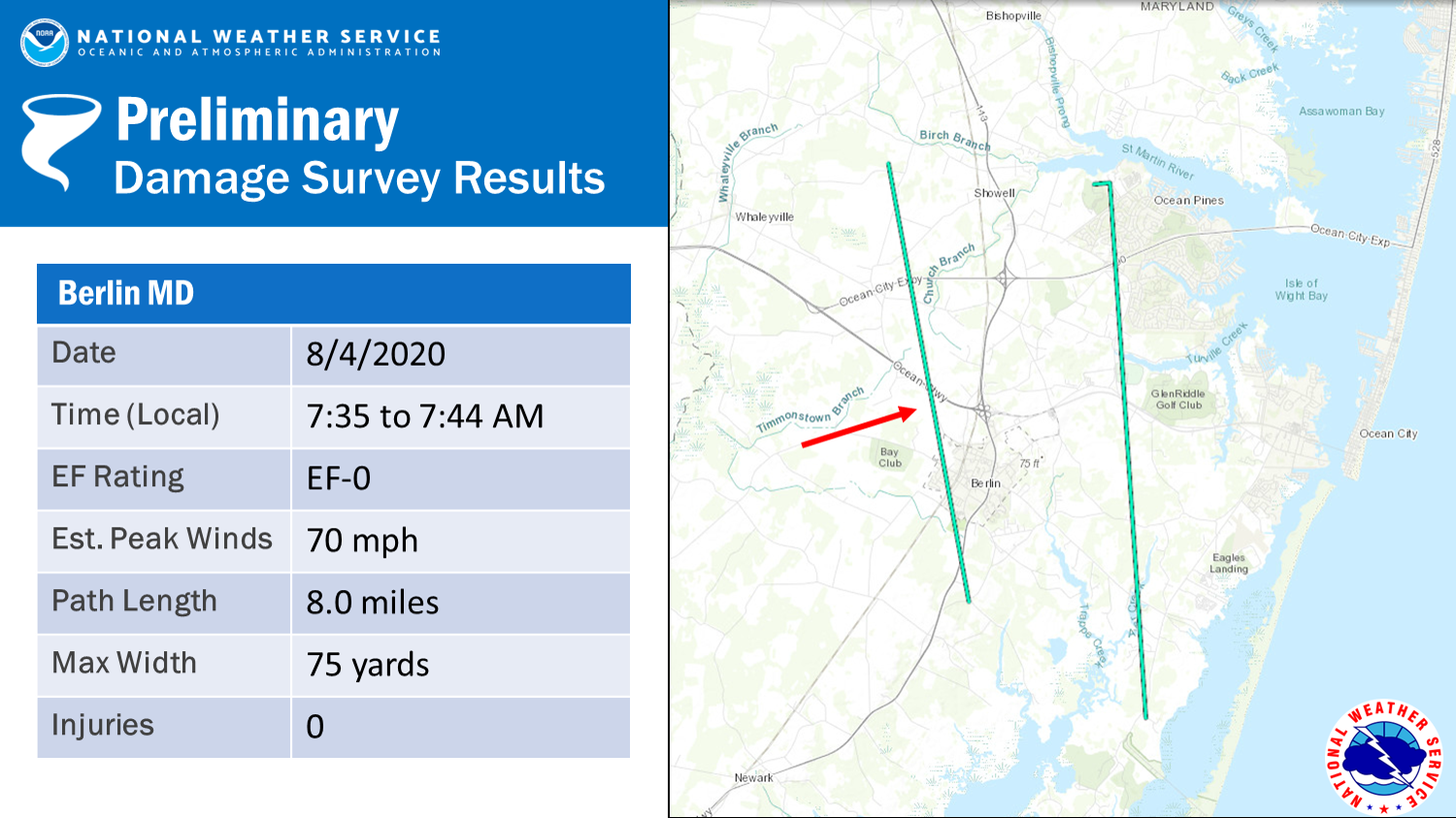 
|
||||||||||||||||
|
Tornado - Ocean Pines MD
Track Map  
|
||||||||||||||||
The Enhanced Fujita (EF) Scale classifies tornadoes into the following categories:
| EF0 Weak 65-85 mph |
EF1 Moderate 86-110 mph |
EF2 Significant 111-135 mph |
EF3 Severe 136-165 mph |
EF4 Extreme 166-200 mph |
EF5 Catastrophic 200+ mph |
 |
|||||
Tidal Flooding
Hydrographs
 |
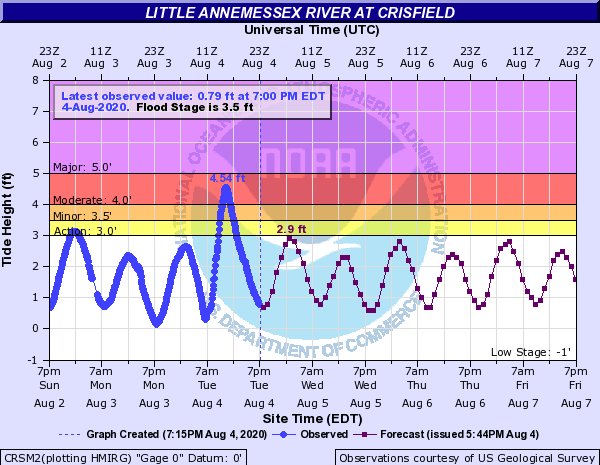 |
 |
 |
| Water Levels at Cambridge, MD | Water Levels at Crisfield, MD | Water Levels at Saxis, VA | Water Levels at Edenton, NC |
Photos
NWS Storm Survey Tornado Damage Photos
 |
 |
 |
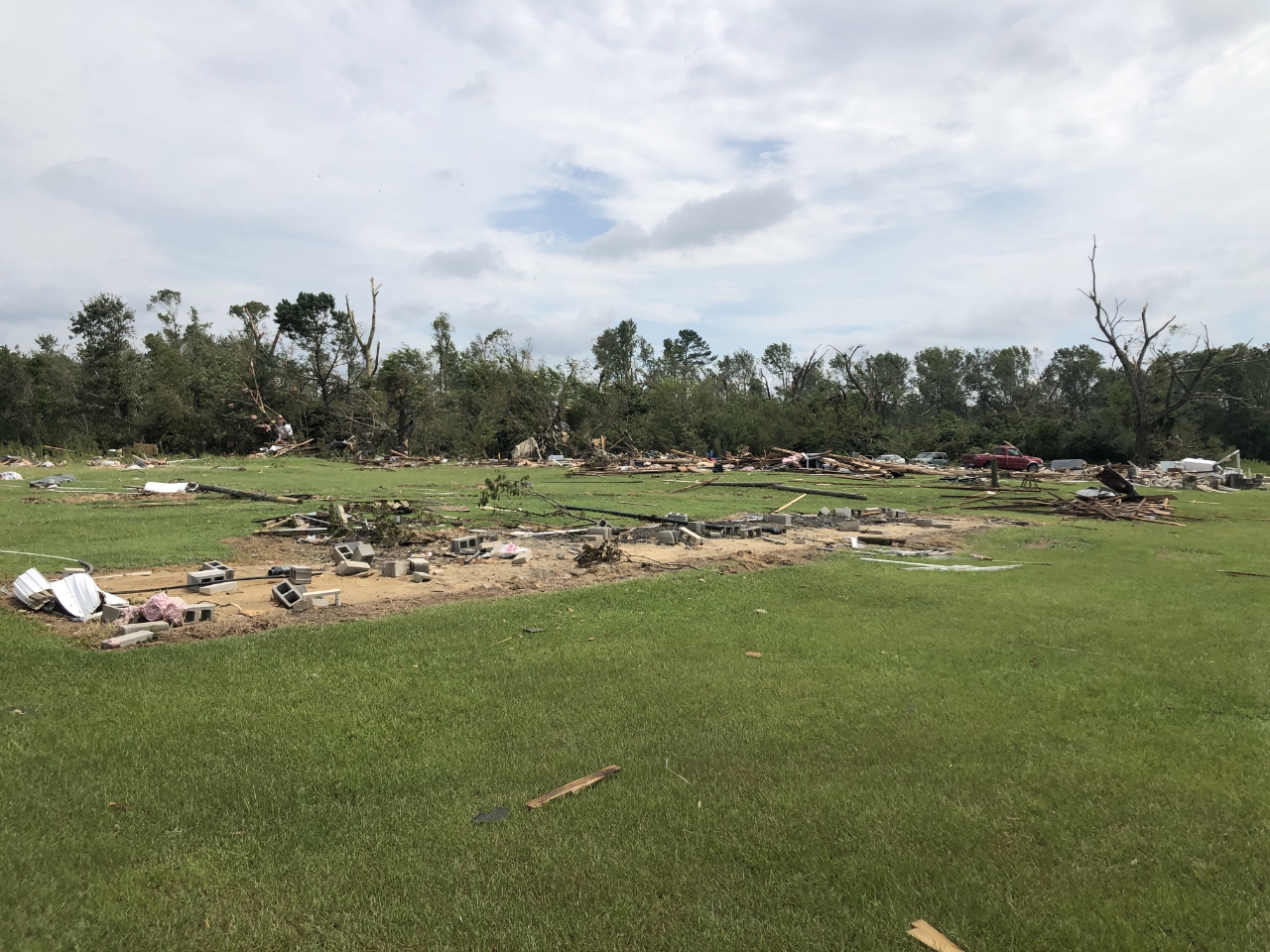 |
| Destruction of a mobile home in Bertie County, NC | Home debris in Bertie County, NC | Home debris in Bertie County, NC | Destruction of trailers in Bertie County, NC |
 |
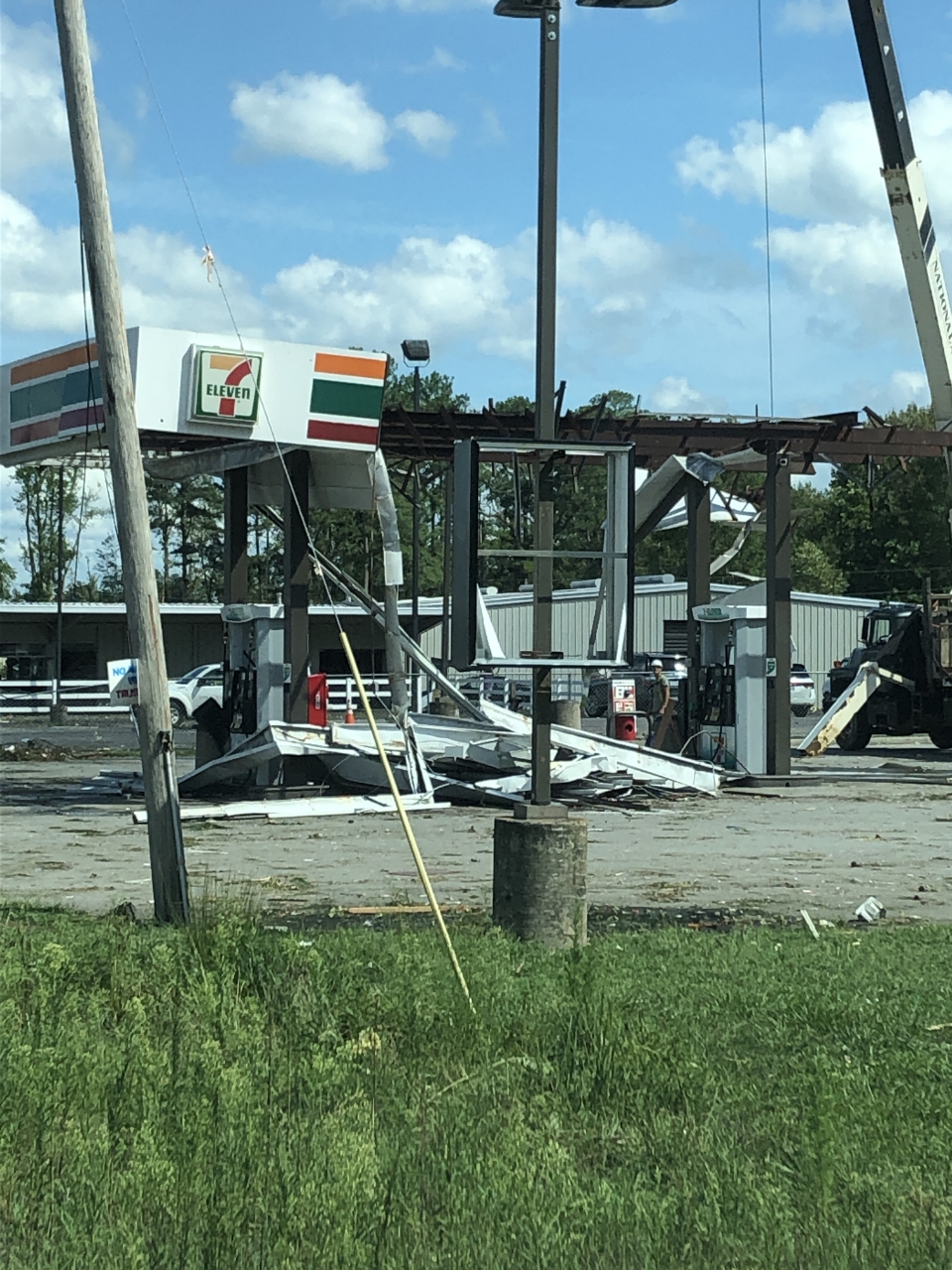 |
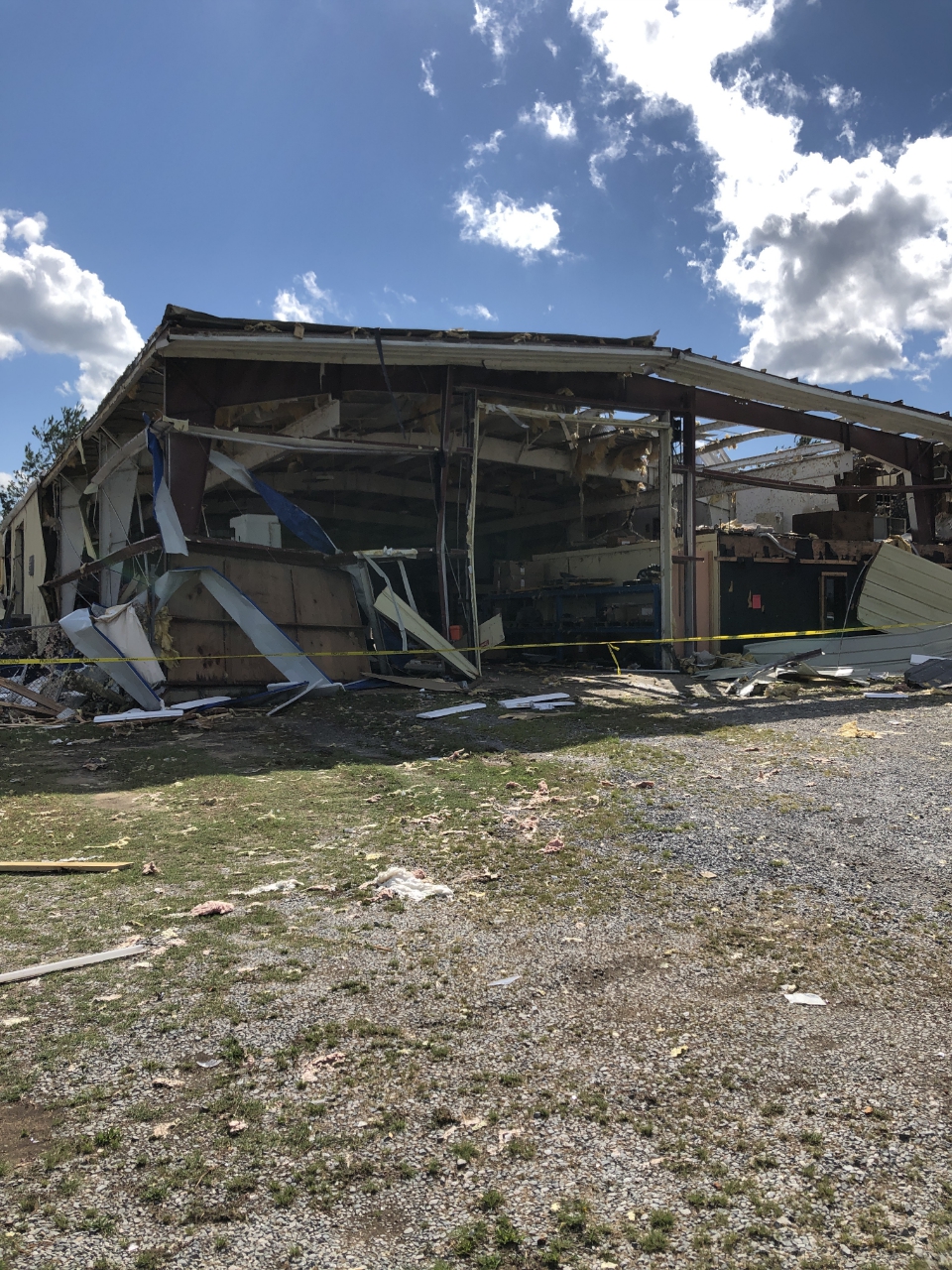 |
 |
| Damage to apartments in Courtland, VA | Damage to a gas station in Courtland, VA | Damage to metal building in Courtland, VA | Damage to tractor business in Courtland, VA |
 |
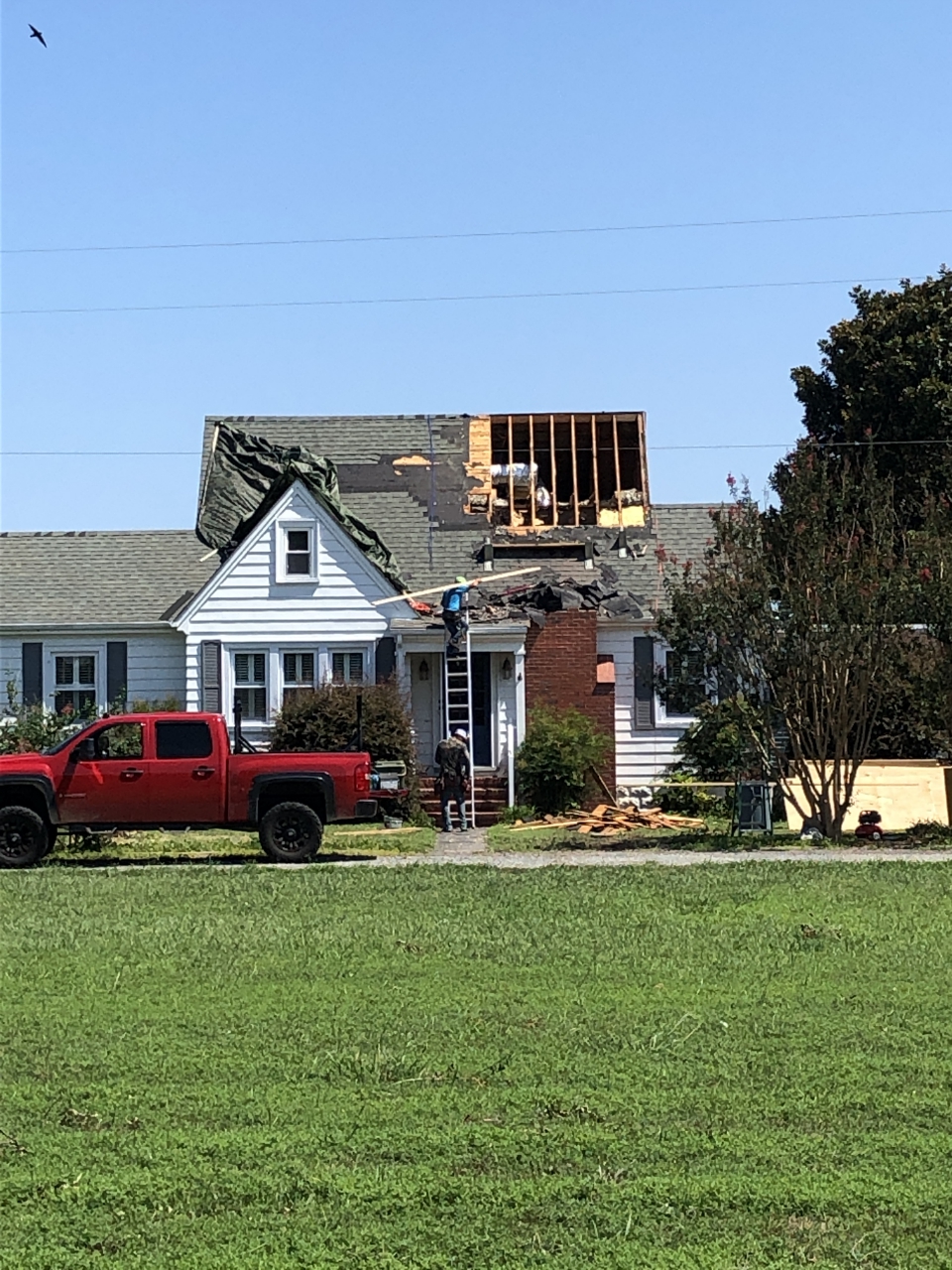 |
 |
 |
| Damage to garage in Fleeton, VA | Damage to a home in Fleeton, VA | Damage to a house in Kilmarnock, VA | Damage to a condo in Kilmarnock, VA |
 |
 |
 |
 |
| Damage in Mardela Springs, MD | Damage in Mardela Springs, MD | Drone footage of damage in Stockton, MD | Drone footage of damage in Stockton, MD |
 |
 |
 |
 |
| Damage to a building in Downtown Suffolk | Tree damage in Riverview area of Downtown Suffolk | Tree damage in Gloucester County, VA | Tree damage in Great Dismal Swamp in VA. |
Radar
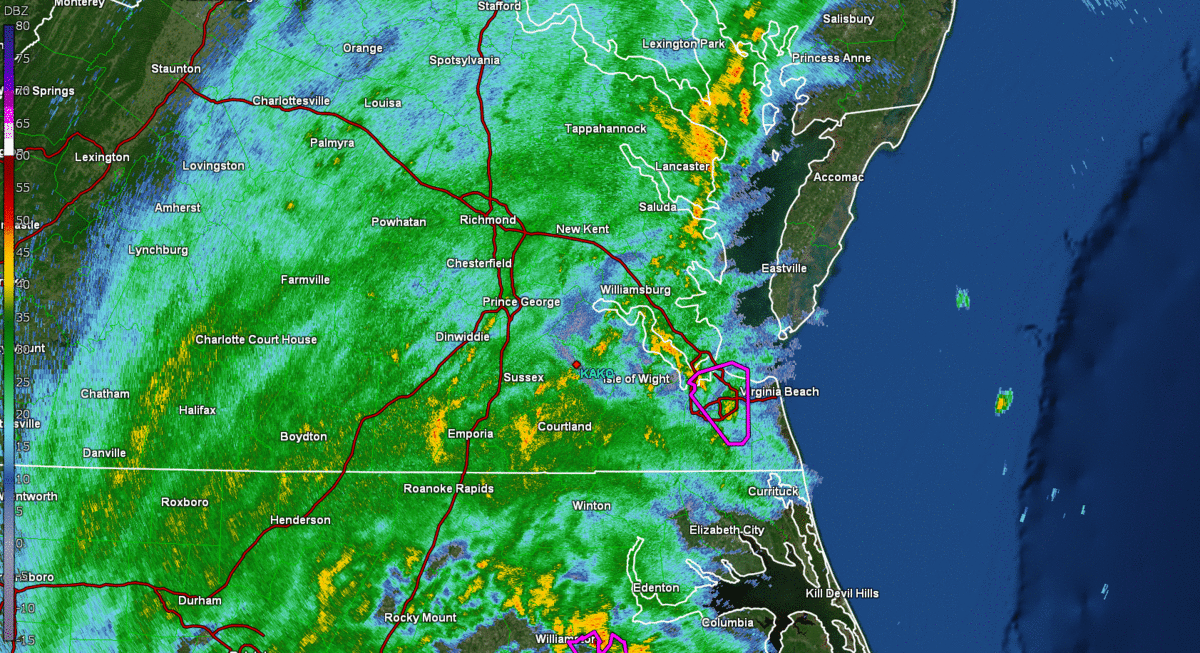 |
| Radar Loop with Tornado Warnings (~1 AM to 720 AM in ~10 minute increments). Note that a few tornadoes touched down on the Lower MD Eastern Shore in the hour after this radar image ends. |
 |
 |
| Loop of Bertie County mini supercell (that produced the EF-3 tornado) from 1:01-1:25 AM. Some descriptions regarding the tornado debris signature are present in the animation. Top left image is 0.5° Base Reflectivity, top right is Base Velocity, bottom left is Differential Reflectivity, and bottom right is Correlation Coefficient. | Loop of mini supercell that produced an EF-2 tornado in Courtland, VA. Top left image is 0.5° Base Reflectivity, top right is Base Velocity, bottom left is Differential Reflectivity, and bottom right is Correlation Coefficient. |
Wind/Rain Reports
 |
 |
| Max Wind Gusts from Isaias | Storm Total Rainfall from Isaias |
...HIGHEST WIND REPORTS... Location Speed Time/Date Lat/Lon ...Maryland... ...Dorchester County... Blackwater 64 MPH 1126 AM 08/04 38.45N/76.09W Cambridge, MD 59 MPH 1048 AM 08/04 38.57N/76.07W Bucktown 57 MPH 1030 AM 08/04 38.46N/76.04W Blackwater 57 MPH 1026 AM 08/04 38.45N/76.09W ...Somerset County... 2 W Marion Station 52 MPH 1028 AM 08/04 38.02N/75.77W ...Wicomico County... Salisbury Wicomico Airport 61 MPH 0755 AM 08/04 38.33N/75.50W ...Worcester County... Assateague Island 68 MPH 1040 AM 08/04 38.08N/75.20W Assateague Island 65 MPH 0940 AM 08/04 38.08N/75.20W Ocean City 58 MPH 1049 AM 08/04 38.32N/75.12W Ocean City 56 MPH 0743 AM 08/04 38.32N/75.12W 1 SSW Ocean City 51 MPH 0930 AM 08/04 38.33N/75.08W ...North Carolina... ...Bertie County... Greens Cross 47 MPH 0517 AM 08/04 36.02N/76.89W ...Chowan County... Edenton 59 MPH 0535 AM 08/04 36.02N/76.57W ...Currituck County... 3.0 E Knotts Island (WEATHER 58 MPH 0720 AM 08/04 36.52N/75.87W 1.6 NW Moyock (WEATHERSTEM) 55 MPH 0720 AM 08/04 36.50N/76.16W Corolla 55 MPH 0700 AM 08/04 36.30N/75.80W ...Northampton County... Conway 53 MPH 1210 PM 08/03 36.43N/77.23W ...Pasquotank County... Elizabeth City Airport 64 MPH 0625 AM 08/04 36.27N/76.18W Elizabeth City 60 MPH 0613 AM 08/04 36.35N/76.28W ...Perquimans County... Chapanoke 69 MPH 0635 AM 08/04 36.24N/76.36W Hertford 54 MPH 0630 AM 08/04 36.16N/76.32W ...Virginia... ...Accomack County... Onancock 70 MPH 0929 AM 08/04 37.65N/75.88W Tangier Sound Light 70 MPH 0623 AM 08/04 37.79N/75.97W Wallops Island 68 MPH 0913 AM 08/04 37.93N/75.47W Wachapreague 66 MPH 0848 AM 08/04 37.60N/75.69W Wachapreague, VA 60 MPH 0906 AM 08/04 37.61N/75.69W Melfa Accomack 54 MPH 0835 AM 08/04 37.63N/75.77W Parksley 53 MPH 0946 AM 08/04 37.73N/75.61W Parksley 53 MPH 0932 AM 08/04 37.73N/75.61W ...City of Chesapeake County... Money Point 53 MPH 0624 AM 08/04 36.78N/76.30W Fentress Naval 49 MPH 0453 AM 08/04 36.70N/76.13W Norfolk Hampton 47 MPH 0649 AM 08/04 36.78N/76.45W ...City of Hampton County... Langley AFB Hamp 59 MPH 0805 AM 08/04 37.07N/76.37W ...City of Newport News County... Newport News 53 MPH 0805 AM 08/04 37.13N/76.50W ...City of Norfolk County... HRBT - South Island 66 MPH 0715 AM 08/04 36.98N/76.30W Lafayette River 63 MPH 0655 AM 08/04 36.89N/76.32W Norfolk Intl Airport 61 MPH 0656 AM 08/04 36.90N/76.20W Norfolk NAS Cham 60 MPH 0703 AM 08/04 36.92N/76.27W Norfolk 46 MPH 0801 AM 08/04 36.86N/76.29W ...City of Poquoson County... Poquoson 68 MPH 0811 AM 08/04 37.11N/76.32W Wythe Creek 51 MPH 0644 AM 08/04 37.11N/76.39W ...City of Portsmouth County... South Norfolk Jordan Bridge 76 MPH 0637 AM 08/04 36.81N/76.29W South Craney Island 64 MPH 0612 AM 08/04 36.89N/76.34W ...City of Suffolk County... Gdr 49 MPH 0726 AM 08/04 36.61N/76.55W Suffolk 49 MPH 0615 AM 08/04 36.68N/76.60W ...City of Virginia Beach County... Cape Henry 68 MPH 0740 AM 08/04 36.93N/76.01W Oceana NAS Souce 67 MPH 0754 AM 08/04 36.82N/76.02W Virginia Beach 59 MPH 0755 AM 08/04 36.75N/75.99W Virginia Beach 57 MPH 0630 AM 08/04 36.77N/76.04W Creeds 52 MPH 0629 AM 08/04 36.59N/76.02W Creeds 48 MPH 0701 AM 08/04 36.63N/76.04W ...Henrico County... Richmond Intl Airport 51 MPH 0722 AM 08/04 37.52N/77.32W ...Mathews County... New Point Comfort 61 MPH 0657 AM 08/04 37.33N/76.27W Gwynn 49 MPH 0750 AM 08/04 37.50N/76.29W ...Middlesex County... Stingray Point 49 MPH 0705 AM 08/04 37.55N/76.30W Saluda 48 MPH 0915 AM 08/04 37.60N/76.45W ...Northampton County... Kiptopeke, VA 69 MPH 0730 AM 08/04 37.17N/75.99W ...Northumberland County... Lewisetta, VA 63 MPH 0924 AM 08/04 38.00N/76.46W ...Maryland... ...Maritime Stations... Ocean City 74 MPH 1004 AM 08/04 38.33N/75.08W Ocean City Inlet 64 MPH 1024 AM 08/04 38.33N/75.09W Assateague South Point 62 MPH 0929 AM 08/04 38.21N/75.20W Ocean City Inlet 57 MPH 0930 AM 08/04 38.33N/75.09W ...Virginia... York River East Rear Range L 74 MPH 0648 AM 08/04 37.25N/76.33W Rudee Inlet 73 MPH 0448 AM 08/04 36.83N/75.97W Willoughby Deguassing Statio 72 MPH 0648 AM 08/04 36.98N/76.32W Rappahannock Light 71 MPH 0812 AM 08/04 37.54N/76.02W Middle Ground Lighthouse 69 MPH 0623 AM 08/04 36.95N/76.39W Cape Henry, VA 68 MPH 0742 AM 08/04 36.93N/76.01W Hampton Flats 68 MPH 0424 AM 08/04 36.98N/76.36W Thimble Shoals 67 MPH 0810 AM 08/04 37.05N/76.26W Sandbridge 66 MPH 0628 AM 08/04 36.70N/75.93W Plantation Flats 66 MPH 0801 AM 08/04 37.26N/76.03W James River Bridge@Isle of W 65 MPH 0800 AM 08/04 37.00N/76.47W Lynnhaven Inlet Light 1L 64 MPH 0733 AM 08/04 36.92N/76.09W MMMBT 64 MPH 0700 AM 08/04 36.94N/76.40W Dominion Terminal 62 MPH 0642 AM 08/04 36.96N/76.42W Yorktown USCG Training Cente 60 MPH 0448 AM 08/04 37.23N/76.48W Deltaville 59 MPH 0902 AM 08/04 37.56N/76.31W 5 NE Plum Tree Island Refuge 58 MPH 0720 AM 08/04 37.20N/76.27W Machipongo 56 MPH 0907 AM 08/04 37.41N/75.97W Poquoson River Light 56 MPH 0436 AM 08/04 37.16N/76.38W Ft Eustis Felker 55 MPH 0636 AM 08/04 37.12N/76.62W 2 E Stingray Point 51 MPH 0536 AM 08/04 37.57N/76.26W Silver Beach 48 MPH 0805 AM 08/04 37.49N/75.97W ---------------------------------------------------------------------------------------------------------------
...STORM TOTAL RAINFALL REPORTS... Location Amount Time/Date Lat/Lon ...Maryland... ...Dorchester County... Cambridge 4.75 in 0946 AM 08/04 38.58N/76.09W NEAVITT 4.21 in 1000 AM 08/04 38.40N/76.10W Blackwater 4.06 in 0826 AM 08/04 38.45N/76.09W Cambridge 3.86 in 1006 AM 08/04 38.58N/76.09W ...North Carolina... ...Bertie County... Greens Cross 3.33 in 0917 AM 08/04 36.02N/76.89W ...Chowan County... Edenton 3.27 in 0800 AM 08/04 36.06N/76.61W ...Northampton County... Henrico 3.96 in 1000 AM 08/04 36.54N/77.86W Henrico 0.4 S 3.77 in 0800 AM 08/04 36.53N/77.83W ...Virginia... ...Amelia County... Ford 3.15 in 1000 AM 08/04 37.23N/77.74W ...Brunswick County... South Hill Meckl 3.77 in 0955 AM 08/04 36.68N/78.03W Alberta 5 N 3.40 in 0800 AM 08/04 36.94N/77.90W Lawrenceville 3.13 in 0955 AM 08/04 36.78N/77.80W ...Caroline County... Hanover 3.0 N 4.35 in 0700 AM 08/04 37.81N/77.36W Faph_eodtc 4.08 in 0832 AM 08/04 38.13N/77.18W Ruther Glen 1.7 ENE 3.70 in 0700 AM 08/04 37.94N/77.43W Bowling Green 3.23 in 1009 AM 08/04 38.04N/77.34W Faph_delos 3.11 in 0833 AM 08/04 38.10N/77.27W Faph_south 1 3.02 in 0833 AM 08/04 38.04N/77.24W ...Charles City County... Charles City County 3.06 in 0710 AM 08/04 37.42N/77.20W ...Chesterfield County... 3 SSW Midlothian 5.93 in 0809 AM 08/04 37.46N/77.66W Chesterfield 5.61 in 1005 AM 08/04 37.32N/77.49W Richmond Chester 4.41 in 0956 AM 08/04 37.40N/77.52W Midlothian 4.40 in 1010 AM 08/04 37.55N/77.66W Richmond 7.5 SW 4.30 in 0700 AM 08/04 37.46N/77.58W Bon Air 2.4 WNW 4.27 in 0700 AM 08/04 37.54N/77.61W Matoaca 4.21 in 1005 AM 08/04 37.29N/77.48W 4 SE Chester 4.15 in 1000 AM 08/04 37.32N/77.38W Chesterfield 4.13 in 1005 AM 08/04 37.34N/77.64W Winterpock 3.87 in 1005 AM 08/04 37.34N/77.64W Midlothian 4.7 SSW 3.86 in 0700 AM 08/04 37.44N/77.67W Midlothian 0.6 NE 3.84 in 0700 AM 08/04 37.51N/77.64W 3.9 SW Beach 3.84 in 0700 AM 08/04 37.32N/77.65W Moseley 1.9 NNW 3.68 in 0800 AM 08/04 37.44N/77.71W Midlothian 3.67 in 1000 AM 08/04 37.38N/77.64W Chester 6.6 E 3.50 in 0700 AM 08/04 37.36N/77.32W Chester 6.6 E 3.35 in 0500 AM 08/04 37.36N/77.32W Midlothian 3.7 SSW 3.32 in 0600 AM 08/04 37.45N/77.67W Chesterfield 3.11 in 1008 AM 08/04 37.45N/77.62W ...City of Emporia County... Emporia Reservoir 3.92 in 0700 AM 08/04 36.70N/77.56W ...City of Franklin County... Franklin 0.5 ESE 3.20 in 0700 AM 08/04 36.68N/76.93W ...City of Hopewell County... 1 NE Hopewell 4.34 in 1010 AM 08/04 37.30N/77.29W ...City of Newport News County... Newport News 9.6 NNW 3.92 in 0650 AM 08/04 37.20N/76.58W Tide 3.42 in 0759 AM 08/04 37.10N/76.55W 1 NW Menchville 3.28 in 0643 AM 08/04 37.11N/76.54W Newport News 3.20 in 0954 AM 08/04 37.13N/76.50W ...City of Richmond County... 2.5 W East Highland Park (IF 4.84 in 0809 AM 08/04 37.56N/77.42W Richmond 4.0 E 4.40 in 0700 AM 08/04 37.53N/77.40W Richmond 2.8 N 4.36 in 0700 AM 08/04 37.57N/77.48W Richmond 1.1 SE 4.17 in 0700 AM 08/04 37.52N/77.46W Richmond 4.2 NNE 3.92 in 0700 AM 08/04 37.59N/77.45W Richmond 1.5 NNW 3.50 in 0710 AM 08/04 37.55N/77.48W Richmond 3.45 in 1007 AM 08/04 37.57N/77.50W ...City of Suffolk County... Suffolk 6.3 N 3.76 in 0700 AM 08/04 36.79N/76.66W Suffolk 13.9 NNE 3.55 in 0630 AM 08/04 36.89N/76.53W Suffolk 3.1 NNW 3.50 in 0700 AM 08/04 36.74N/76.67W Suffolk 3.45 in 0616 AM 08/04 36.88N/76.48W Suffolk 3.34 in 0601 AM 08/04 36.87N/76.50W Suffolk 3.24 in 1000 AM 08/04 36.92N/76.49W Suffolk 3.11 in 0955 AM 08/04 36.68N/76.60W Gdr 3.05 in 0826 AM 08/04 36.61N/76.55W ...City of Williamsburg County... Williamsburg 1.3 SSW 5.32 in 0700 AM 08/04 37.25N/76.72W Williamsburg 1.0 SSW 4.96 in 0700 AM 08/04 37.26N/76.71W Williamsburg 1.4 ENE 4.65 in 0730 AM 08/04 37.28N/76.68W Williamsburg 3.24 in 1010 AM 08/04 37.28N/76.71W ...Dinwiddie County... Petersburg 4.23 in 0955 AM 08/04 37.17N/77.52W ...Essex County... Dunnsville 5.26 in 1008 AM 08/04 37.89N/76.81W ...Gloucester County... Gloucester Courthouse 3.3 SS 3.45 in 0800 AM 08/04 37.37N/76.55W Gloucester Courthouse 5.8 SS 3.38 in 0800 AM 08/04 37.33N/76.57W Gloucester Point 4.7 NW 3.10 in 0800 AM 08/04 37.31N/76.56W ...Greensville County... Emporia 11.0 SW 4.57 in 0700 AM 08/04 36.57N/77.66W Purdy 4.21 in 1005 AM 08/04 36.79N/77.57W ...Hanover County... Mechanicsville 4.26 in 1007 AM 08/04 37.60N/77.33W Richmond Hanover 4.21 in 0954 AM 08/04 37.70N/77.43W Beaverdam 4.3 ESE 3.72 in 0700 AM 08/04 37.91N/77.59W Beaverdam 3.70 in 1002 AM 08/04 37.94N/77.63W Montpelier 4.8 E 3.58 in 0705 AM 08/04 37.82N/77.59W Ashland 3.07 in 1000 AM 08/04 37.75N/77.48W ...Henrico County... Richmond Intl Airport 5.20 in 1005 AM 08/04 37.52N/77.32W Montrose 4.7 SSE 5.07 in 0700 AM 08/04 37.46N/77.35W Highland Springs 8.1 SE 4.58 in 0830 AM 08/04 37.48N/77.21W Richmond 4.12 in 1001 AM 08/04 37.63N/77.63W Glen Allen 4.11 in 1009 AM 08/04 37.66N/77.50W Sandston 5.9 ESE 3.82 in 0701 AM 08/04 37.51N/77.21W Glen Allen 3.73 in 1000 AM 08/04 37.69N/77.59W Richmond 3.62 in 1007 AM 08/04 37.64N/77.65W Glen Allen 1.4 WNW 3.51 in 0830 AM 08/04 37.67N/77.51W Richmond 4.8 N 3.50 in 0700 AM 08/04 37.60N/77.47W Richmond 3.49 in 1010 AM 08/04 37.60N/77.58W Glen Allen 6.6 W 3.34 in 0700 AM 08/04 37.67N/77.60W 1 S Chamberlayne 3.13 in 1010 AM 08/04 37.60N/77.43W Glen Allen 4.6 W 3.07 in 0647 AM 08/04 37.66N/77.57W ...Isle of Wight County... Smithfield 7.2 W 4.37 in 0600 AM 08/04 36.99N/76.75W Carrollton 3.52 in 0600 AM 08/04 36.93N/76.53W Smithfield 0.7 NE 3.51 in 0700 AM 08/04 36.99N/76.61W 1 NE Rushmere 3.05 in 0550 AM 08/04 37.10N/76.66W Windsor 0.5 ENE 3.03 in 0626 AM 08/04 36.81N/76.73W ...James City County... Williamsburg 6.5 NW 6.80 in 0700 AM 08/04 37.35N/76.77W Ford`s Colony 6.09 in 1008 AM 08/04 37.30N/76.75W Williamsburg 1.9 SW 5.51 in 0800 AM 08/04 37.25N/76.73W Williamsburg 6.1 NW 5.43 in 0800 AM 08/04 37.34N/76.78W Williamsburg 3.2 W 5.21 in 0700 AM 08/04 37.27N/76.76W Williamsburg 4.5 NW 5.05 in 0900 AM 08/04 37.31N/76.78W Williamsburg 3.5 SW 4.85 in 0750 AM 08/04 37.23N/76.75W Williamsburg 3.2 WNW 4.79 in 0700 AM 08/04 37.28N/76.76W Williamsburg 9.1 NNW 4.62 in 0700 AM 08/04 37.39N/76.78W Williamsburg 1.6 ESE 4.51 in 0700 AM 08/04 37.27N/76.68W Williamsburg 3.1 SSE 4.35 in 0800 AM 08/04 37.23N/76.68W Williamsburg 4.1 WNW 4.31 in 0700 AM 08/04 37.28N/76.78W Williamsburg 3.8 WSW 4.20 in 0700 AM 08/04 37.24N/76.77W Williamsburg 4.7 WSW 4.08 in 0630 AM 08/04 37.26N/76.79W Toano 3.9 WSW 3.56 in 0800 AM 08/04 37.36N/76.87W Williamsburg 5.8 WSW 3.53 in 0700 AM 08/04 37.25N/76.81W Williamsburg 5.7 W 3.21 in 0800 AM 08/04 37.27N/76.81W ...King and Queen County... West Point 3.33 in 0955 AM 08/04 37.52N/76.77W ...Lancaster County... Mollusk 4.16 in 1001 AM 08/04 37.71N/76.53W Urbanna 6.2 NNE 4.15 in 0800 AM 08/04 37.72N/76.52W Lancaster 3.96 in 1002 AM 08/04 37.73N/76.51W Kilmarnock 3.64 in 1010 AM 08/04 37.71N/76.38W ...Louisa County... Gum Spring 3.5 NNW 3.04 in 0804 AM 08/04 37.82N/77.92W ...Mecklenburg County... John H Kerr Dam 3.39 in 0900 AM 08/04 36.60N/78.30W ...Middlesex County... White Stone 8.0 SSW 5.44 in 0700 AM 08/04 37.54N/76.44W Remlik 3.99 in 1005 AM 08/04 37.68N/76.62W Locust Hill 1.1 ENE 3.40 in 0700 AM 08/04 37.61N/76.49W Hartfield 3.35 in 0646 AM 08/04 37.56N/76.51W ...Northumberland County... Heathsville 4.6 SE 3.93 in 0647 AM 08/04 37.87N/76.42W Heathsville 3.20 in 1001 AM 08/04 37.93N/76.32W ...Nottoway County... Blackstone 4.69 in 1005 AM 08/04 37.07N/78.00W Burkeville 1.9 SSE 3.56 in 0700 AM 08/04 37.16N/78.19W Crewe 3.46 in 1002 AM 08/04 37.18N/78.13W ...Prince George County... 1.6 SE Disputanta 5.53 in 0700 AM 08/04 37.11N/77.20W Prince George 3.2 ENE 4.98 in 0800 AM 08/04 37.24N/77.23W James River 4.34 in 0951 AM 08/04 37.26N/77.14W Disputanta 6.3 NE 4.32 in 0700 AM 08/04 37.19N/77.15W 1 ESE Disputanta 3.81 in 1005 AM 08/04 37.11N/77.20W 2 WSW Garysville 3.26 in 1010 AM 08/04 37.23N/77.20W Prince George 3.23 in 1010 AM 08/04 37.22N/77.29W ...Southampton County... Sedley 3.7 N 3.90 in 0620 AM 08/04 36.83N/76.99W ...Surry County... Claremont 0.2 SW 4.06 in 0658 AM 08/04 37.23N/76.97W ...Sussex County... Wakefield 0.1 ENE 3.79 in 0800 AM 08/04 36.97N/76.99W Norfolk Wakefld 3.72 in 0954 AM 08/04 36.98N/77.00W ...Westmoreland County... Stratford 0.5 NE 3.17 in 0700 AM 08/04 38.15N/76.84W ...York County... Williamsburg 6.0 N 6.16 in 0800 AM 08/04 37.36N/76.70W Williamsburg 6.02 in 1001 AM 08/04 37.35N/76.70W Williamsburg 4.4 N 5.56 in 0700 AM 08/04 37.33N/76.71W Williamsburg 4.27 in 1008 AM 08/04 37.27N/76.68W
Environment
Synoptic Summary.
 |
 |
 |
 |
| 8 PM 8/3 WPC Surface Analysis | 8 PM 8/3 500 mb NAM Analysis-Isaias starting to get picked up by upper trough to the west | 8 AM 8/4 WPC Surface Analysis | 8 AM 8/4 500 mb NAM Analysis - Isaias accelerating to the NNE over Virginia as it continues to get absorbed by the large upper trough |
Additional Environmental Data
 |
 |
| Loop of MSLP/Temperature/Dewpoint/Wind (Left) and Surface Observations (right) from 03z/11 PM to 18z/2 PM in 3 hour increments. Note the north-south oriented boundary and resulting temperature gradient (just E of I-95) that served as a focus for the tornadoes that occurred in our area. | 8 PM 8/3 NAM Analysis of 250 mb Heights/Winds |
Instability/Shear Parameters
 |
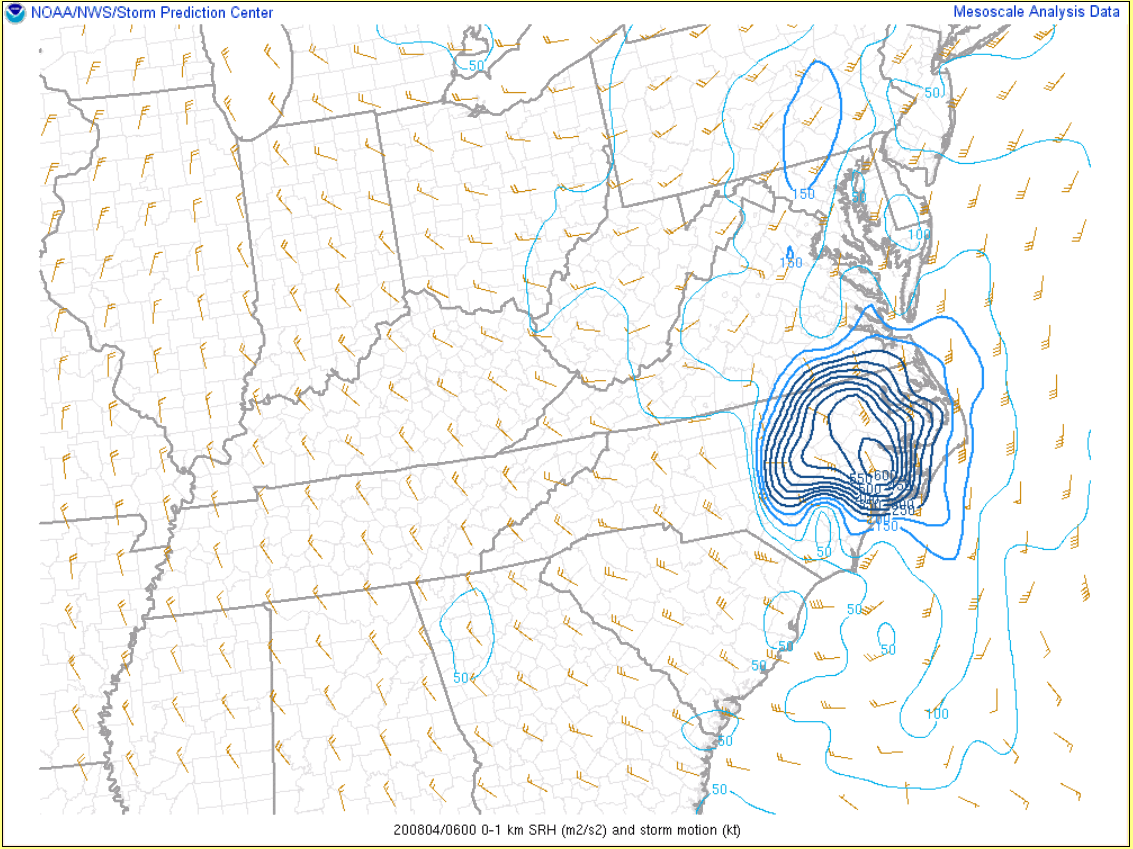 |
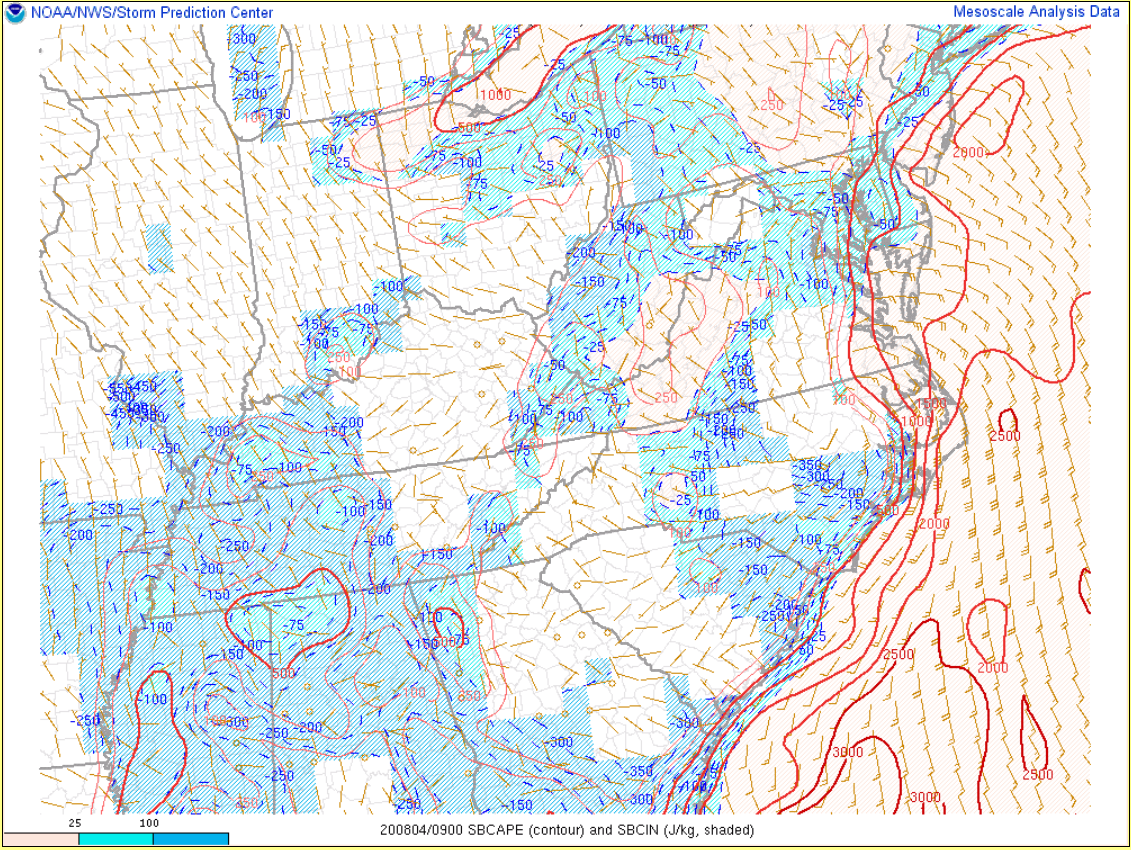 |
 |
| 2 AM SBCAPE/CIN/Wind | 2 AM 0-1 km SRH | 5 AM SBCAPE/CIN/WInd | 5 AM 0-1 km SRH |
Sounding/Low-Level Wind Data
 |
 |
 |
 |
| 06z/2 AM RAP Analysis Sounding from Bertie County | 06z/2 AM RAP 925 mb Analysis of Heights/Winds | 09z/5 AM RAP Analysis Sounding from KPHF. | 09z/5 AM RAP 925 mb Analysis of Heights/Winds |
 |
Media use of NWS Web News Stories is encouraged! Please acknowledge the NWS as the source of any news information accessed from this site. |
 |